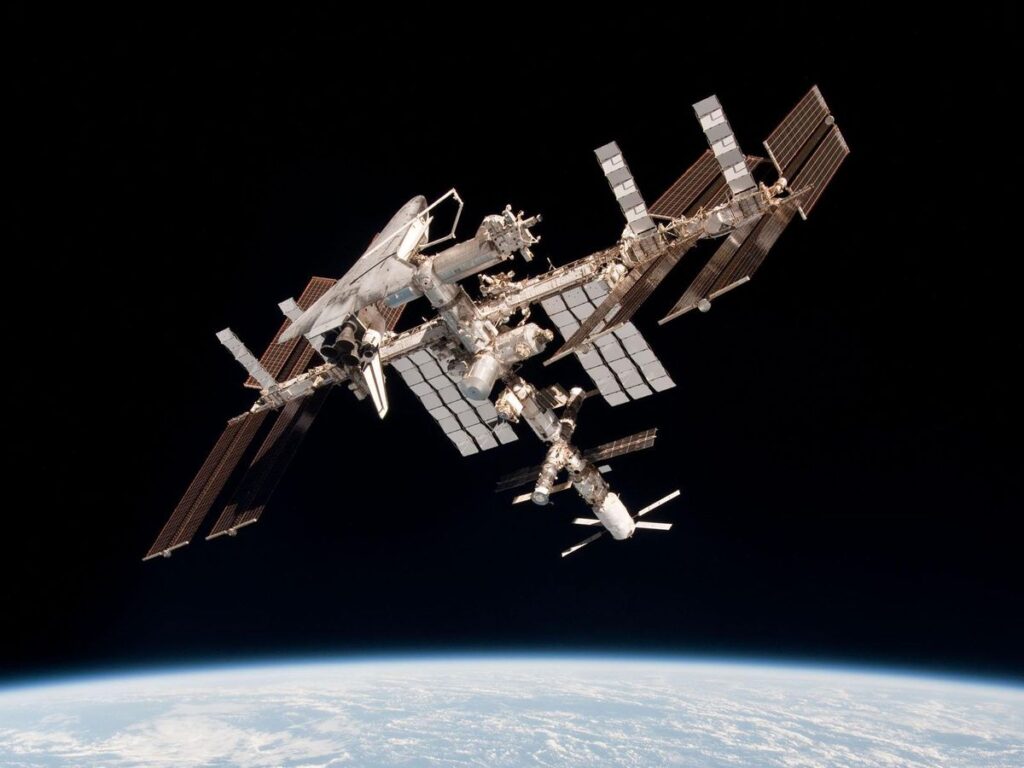Space stations, such as the International Space Station (ISS), are marvels of modern technology and collaboration, offering a unique environment for scientific discovery and technological advancement. They serve as a testament to human ingenuity and a platform for experiments that cannot be conducted on Earth. In this article, we explore the workings of space stations, the technology that powers them, and the multitude of benefits they bring to humanity, including their role in inspiring future generations and paving the way for deep space exploration.
Key Takeaways
- The ISS functions as a vital scientific laboratory and a test bed for technology that will enable future space exploration.
- Space stations like the ISS and the upcoming Starlab provide unique environments for research breakthroughs in areas such as medicine and material science.
- Living in microgravity aboard the ISS requires advanced life support systems and has led to adaptations in daily human activities.
- Technological advancements developed for space stations often result in spinoffs that benefit life on Earth, including in healthcare and environmental monitoring.
- International collaboration and commercial partnerships are expanding access to low Earth orbit, fostering innovation and the commercialization of space.
The International Space Station: A Hub of Scientific Discovery

Space Station Research and Technology
The International Space Station (ISS) serves as a multifaceted laboratory, where astronauts conduct research across various scientific disciplines. The unique microgravity environment of the ISS offers unparalleled opportunities for scientific discovery that cannot be replicated on Earth. This has led to significant advancements in medicine, engineering, biotechnology, physics, materials science, and Earth science.
The ISS functions as both a laboratory and a proving ground for technology that will be critical for long-duration space missions.
Research aboard the ISS has already yielded results with direct benefits to Earth, such as the discovery of therapeutic targets for MRSA and Salmonella infections. As the station continues to operate, it is expected to contribute even more to our understanding of science and technology.
Fields of Research on the ISS:
- Medicine: Development of new pharmaceutical agents.
- Engineering: Advancements in construction and design.
- Biotechnology: Understanding biological processes in microgravity.
- Physics: Studying fundamental forces and particles.
- Materials Science: Creating new materials with unique properties.
- Earth Science: Observing and analyzing planetary changes from space.
Station Benefits for Humanity
The International Space Station (ISS) serves as a beacon of international cooperation and scientific advancement. Its contributions extend far beyond the realm of space exploration, impacting lives and industries across the globe. Here are some of the key benefits humanity has reaped from the ISS:
- Medical Advancements: The ISS has been instrumental in refining ultrasound technologies for use in remote locations, potentially saving lives where medical care is not readily accessible.
- Sustainability Initiatives: Innovations in solar array design and other sustainability efforts developed for the ISS have found applications on Earth, leading to more efficient use of resources.
- Scientific Breakthroughs: The unique microgravity environment of the ISS allows for research that is not possible on Earth, leading to discoveries in various fields of science.
- Preparation for Deep Space: The ISS provides a platform to study the effects of long-duration spaceflight on the human body, essential for future missions to the Moon and Mars.
The synergy between space technology and Earthly applications underscores the invaluable role of the ISS in driving innovation and fostering a sustainable future.
Collaborative Efforts and International Partnerships
The International Space Station (ISS) represents a pinnacle of international cooperation in space exploration. Agencies from the United States, Russia, Europe, Japan, and Canada have come together to create and maintain this unique laboratory in the sky. The ISS has been a testament to what can be achieved when nations unite for a common scientific and exploratory goal.
The partnership framework has proven to be a valuable asset, not just for the ISS, but for future space endeavors as well. It is a model of how complementary abilities and resources can enhance the success and safety of missions beyond our atmosphere. This collaborative approach is paving the way for more ambitious projects, such as a crewed mission to Mars, which is anticipated to be a multinational effort.
The ISS serves as a beacon of international unity, demonstrating the incredible achievements possible when the world works together in the pursuit of knowledge and exploration.
The table below outlines some of the key international partnerships and initiatives that have been instrumental in the success of the ISS and other space-related collaborations:
| Initiative | Description |
|---|---|
| Space Station Intergovernmental Agreement | Signed on January 28, 1998, it laid the foundation for international cooperation on the ISS. |
| Shuttle-Mir Program | A collaborative space program between Russia and the United States that set the stage for the ISS. |
| Joint Comprehensive Plan of Action | An example of international diplomatic efforts that can parallel the cooperative spirit found in space exploration. |
Living and Working in Microgravity: Life Aboard the ISS

Daily Life and Adaptation to Zero-G
Adapting to life in microgravity is a unique challenge for astronauts aboard the International Space Station (ISS). Daily routines are redefined as simple tasks like eating, sleeping, and personal hygiene require special equipment and procedures. The absence of gravity means that astronauts must secure themselves to avoid floating away during sleep or while using the treadmill with bungee cords for exercise.
In the weightless environment of the ISS, astronauts experience a complete shift in their perception of orientation. This can lead to initial disorientation, with crew members sometimes feeling upside down or misjudging distances and speeds.
Astronauts quickly learn to navigate the station’s confines, adapting to the three-dimensional space where ‘up’ and ‘down’ are relative concepts. The list below highlights some of the adaptations necessary for daily life in zero-G:
- Secure sleeping quarters to prevent drifting
- Velcro straps to hold tools and personal items
- Magnetic soles on shoes to ‘walk’ on designated surfaces
- Specialized space toilets designed for microgravity
- Carefully planned meals that minimize crumbs and floating debris
These adaptations are not only essential for comfort but also for the safety and efficiency of the crew as they conduct important research and maintain the station’s operations.
Scientific Experiments in a Unique Environment
The International Space Station (ISS) serves as a unique laboratory for scientific research, unattainable in Earth’s gravity-bound laboratories. The microgravity environment of space allows for experiments across various disciplines, from biology to physics, which can lead to breakthroughs in our understanding of fundamental processes.
Research aboard the ISS is highly efficient, as it enables multiple experiments to share resources such as launches and crew time. This collaborative approach not only streamlines the research process but also provides scientists on Earth with real-time data, allowing for dynamic adjustments to ongoing experiments.
The ISS’s capability to conduct complex research in microgravity has profound implications for both space exploration and terrestrial applications.
One of the challenges in space is maintaining a sterile environment, as traditional culture-based methods for detecting microbes are limited. The ISS employs advanced molecular-based methods, enhancing our knowledge of microbiological environmental hazards and informing safety protocols for astronauts and similar closed environments on Earth.
The Role of the ISS as a Proving Ground for Future Missions
The International Space Station (ISS) serves as a critical proving ground for future space exploration. It offers a unique environment to test systems and conduct operations essential for longer missions to the Moon and Mars. Here, astronauts gain experience in spacecraft maintenance and repair, which are invaluable for ensuring the success of future interplanetary voyages.
- The ISS tests spacecraft systems in low Earth orbit.
- It provides experience in operations and maintenance.
- The station reduces mission risks for future explorations.
The ISS’s role extends beyond research; it is a laboratory, observatory, and a base for staging future missions. Its contribution to space exploration is multifaceted, encompassing commercial, diplomatic, and educational objectives.
The station’s ability to support long-term studies with human researchers on board distinguishes it from uncrewed spacecraft. This long-term environment is conducive to a range of research fields, enhancing our understanding of space and improving life on Earth.
Technological Marvels of Space Stations

Advanced Life Support Systems
Space stations like the ISS are equipped with sophisticated Environmental Control and Life Support Systems (ECLSS) that make human life possible in the vacuum of space. An ECLSS is vital for providing fresh air, clean water, and maintaining a safe atmosphere by removing carbon dioxide and other contaminants.
The ECLSS is composed of several subsystems, each designed to handle specific aspects of the station’s environment:
- Atmosphere Control System: Regulates oxygen and nitrogen levels to mimic Earth’s atmosphere.
- Water Supply System: Recycles water from various sources, including astronaut’s sweat and exhaled moisture.
- Waste Management System: Processes waste products to minimize the need for resupply.
- Thermal Control System: Maintains the station’s temperature within habitable limits.
Future space missions will require even more advanced life support systems, as the ability to resupply diminishes with increasing distance from Earth. These systems will need to be highly efficient and autonomous, capable of supporting crew members for extended periods without external aid.
The table below summarizes the key components of the ISS ECLSS and their functions:
| Component | Function |
|---|---|
| Atmosphere Revitalization | Removal of CO2 and trace contaminants |
| Water Recovery and Management | Recycling of water from urine, sweat, and cabin humidity |
| Waste and Hygiene Management | Processing of solid and liquid waste |
| Thermal Control | Regulation of station temperature and humidity |
The integration of these systems is a testament to human ingenuity and the collaborative spirit of the international community working together to sustain life in the harsh environment of space.
Communication and Navigation Technologies
The International Space Station (ISS) utilizes a sophisticated array of communication and navigation technologies to maintain constant contact with Earth. The backbone of this system is the Tracking and Data Relay Satellite System (TDRSS), positioned in geostationary orbit, which provides nearly uninterrupted real-time communication with mission control centers such as the Christopher C. Kraft Jr. Mission Control Center in Houston.
Radio communications are vital for telemetry and scientific data transfer, as well as for the coordination during rendezvous and docking maneuvers. The ISS boasts both internal and external communication systems tailored for various operational needs, including audio and video links that connect crew members with flight controllers and their families.
The seamless integration of these technologies ensures that astronauts are never out of reach, facilitating a continuous exchange of information and enhancing the safety of space missions.
Additionally, the ISS’s communication infrastructure has evolved to include wireless networks within modules, allowing for efficient data exchange and connectivity between different parts of the station.
Energy Generation and Sustainability in Space
The International Space Station (ISS) harnesses the power of the sun to generate electricity, a critical component for sustaining life and operations in space. Solar panels, sprawling wings of photovoltaic cells, convert sunlight directly into electrical power. This energy is essential not only for the station’s day-to-day functions but also for conducting scientific research.
To manage the high potential voltage difference between the station and the ionosphere, plasma contactor units are employed. These units ensure the safety and integrity of the station’s systems by creating current paths that prevent arcing and sputtering due to the spacecraft plasma sheath.
The sustainability of space habitats hinges on efficient energy systems and the ability to maintain life support. As we venture further into space, the lessons learned from the ISS’s energy systems will pave the way for future missions, where resupplying resources like air and water is not feasible.
Here is a brief overview of the ISS’s power and thermal control systems:
- Solar Arrays: Capture sunlight and convert it to electricity.
- Batteries: Store excess energy for use during the orbital night.
- Plasma Contactor Units: Mitigate electrical potential differences.
- Thermal Control Systems: Regulate the station’s temperature.
The Future of Orbital Habitats: From ISS to Starlab

Transitioning to Commercial Space Stations
The era of the International Space Station (ISS) has been a testament to international cooperation and scientific progress. However, the future of orbital habitats is set to take a transformative leap through the Commercial LEO Destinations (CLD) program. This initiative marks a significant shift as NASA begins to incentivize the private sector to develop their own space stations, with the aim of ensuring a sustainable human presence in low Earth orbit beyond the lifespan of the ISS.
With the advent of commercial space stations, a new chapter in space exploration is unfolding. The private sector’s involvement is expected to spur innovation, reduce costs, and increase access to space for a variety of users. Among the anticipated commercial stations, Starlab stands out as a pioneering endeavor, poised to become the first of its kind.
The transition from government-operated to commercially-run space stations represents a pivotal moment in space history. It embodies the evolution of space exploration from a state-sponsored enterprise to a domain where private industry plays a leading role.
The table below outlines some of the key players and their proposed commercial space stations, reflecting the diversity and potential of the upcoming market:
| Company | Proposed Station | Status |
|---|---|---|
| Axiom Space | Axiom Station | In Development |
| Bigelow Aerospace | B330 | On Hold |
| Nanoracks, Voyager Space, and Lockheed Martin | Starlab | In Development |
Starlab: A New Vision for LEO Research
Starlab represents a significant leap forward in the commercialization of low Earth orbit (LEO). As the first continuously crewed, free-flying commercial space station, it is poised to become a new-era global space platform. The station’s dual-module design will cater to a variety of users, from space agencies to private companies, ensuring that the legacy of the ISS in fostering human presence in space continues.
The objectives of Starlab are multifaceted, aiming to sustain human presence in LEO and to provide a state-of-the-art environment for microgravity research and manufacturing. It will support a global customer base, including space tourism, and contribute to scientific and technological advancements. The commitment to extending space commercialization is evident in the collaboration with NASA’s Commercial LEO Destinations program, which has been instrumental in funding and guiding the development of Starlab.
Starlab’s emergence as a commercial venture is a testament to the evolving landscape of space exploration, where public-private partnerships are becoming the cornerstone of sustainable space endeavors.
Expanding Access to Space Through Commercial Partnerships
The advent of commercial space stations like Starlab heralds a new era in low Earth orbit (LEO) utilization, promising to broaden the horizons for scientific and technological development. By fostering commercial partnerships, space agencies and private companies are working together to create economic opportunities and advance science and technology.
The collaboration between entities such as Boeing and Nanoracks on projects like the Bishop Airlock is a testament to the growing synergy in space exploration. This partnership not only enhances the capabilities of the ISS but also paves the way for more commercial users and research initiatives.
The commercialization of space, once spearheaded by NASA’s market opening for launch capacity, is now being propelled further by ventures like Starlab. The CLD program and Starlab represent significant milestones in this journey, marking the transition to the first-ever built commercial space station.
- Agencies support regulating the commercial space industry
- Observing our planet from low Earth orbit
- A rising space industry will create new jobs and products
The Broader Impact of Space Stations on Humanity

Inspiring the Next Generation of Explorers
Space stations like the ISS serve as a beacon of inspiration for young minds across the globe. The allure of space exploration ignites the imagination of students, encouraging them to pursue careers in science, technology, engineering, and mathematics (STEM). Programs and initiatives by space agencies play a pivotal role in this educational outreach.
By engaging with space-related educational content, children learn not only about the mechanics of spaceflight but also about the broader implications of space exploration for society and our understanding of the universe.
- NASA’s educational resources and challenges, such as the ‘Power to Explore STEM Writing Challenge’ and ‘Snap It! Computer Game’, make learning about space fun and accessible.
- JAXA’s ‘Seeds in Space’ experiments allow students to investigate the effects of spaceflight on plant seeds, fostering a hands-on approach to learning.
- The ’10 Ways Students Can Prepare to #BeAnAstronaut’ initiative provides a roadmap for aspiring spacefarers, highlighting the skills and knowledge necessary for a career in space exploration.
Technological Spinoffs and Earthly Applications
The advancements made in space technology often find their way back to Earth, leading to significant improvements in various industries and everyday life. NASA’s innovations for space exploration have the potential to evolve into technologies with broader use on Earth, impacting fields such as medicine, environmental monitoring, and manufacturing.
- Medicine: Advancements in telemedicine, diagnostic devices, and health monitoring systems.
- Environmental Monitoring: Enhanced weather forecasting, climate research, and disaster management tools.
- Manufacturing: Improved materials and processes, including 3D printing technologies.
- Public Safety: Development of better firefighting equipment and emergency response systems.
The ripple effect of space technology is profound, with applications that could help scientists improve substances for a variety of uses, including firefighting, water treatment, and the production of detergents, food, and medicine on Earth.
Deep Space Exploration and the Artemis Program
The Artemis program, led by NASA, marks a significant milestone in deep space exploration, aiming to establish a sustainable human presence on the Moon as a precursor to future Mars missions. The Gateway space station will play a crucial role in this endeavor, serving as a lunar orbit habitat and science laboratory.
The Artemis missions will leverage the collective expertise and technology developed through the International Space Station’s legacy. The program’s ambitious goals include not only landing the first woman and the next man on the lunar surface but also fostering international collaboration and commercial partnerships.
The Artemis Accords, underpinning the program, emphasize a commitment to peaceful exploration, transparency, and cooperation among spacefaring nations, ensuring that space activities benefit all of humanity.
The following table outlines the planned progression of the Artemis missions:
| Mission | Objective | Launch Year |
|---|---|---|
| Artemis I | Uncrewed test flight of Orion spacecraft | 2021 |
| Artemis II | Crewed lunar flyby | 2023 |
| Artemis III | Human lunar landing | 2024 |
Conclusion
The exploration of space stations such as the International Space Station (ISS) and the upcoming Starlab has illuminated the vast potential of human ingenuity in the cosmos. These marvels of science and technology serve not only as homes away from home for astronauts but also as cutting-edge laboratories where groundbreaking research is conducted. The benefits of space stations extend far beyond their walls, offering advancements in medicine, technology, and deep space exploration that enhance life on Earth. As we continue to expand our presence in low Earth orbit and beyond, space stations will undoubtedly play a pivotal role in shaping the future of humanity’s interstellar aspirations.
Frequently Asked Questions
What is the purpose of the International Space Station?
The International Space Station (ISS) serves as a scientific laboratory, a test bed for deep-space technology, and a home for astronauts, enabling scientific research and technological breakthroughs not possible on Earth.
How does research on the ISS benefit humanity?
Research conducted on the ISS leads to discoveries and technological advancements that improve life on Earth. Examples include the development of new pharmaceutical agents to combat infections like MRSA and Salmonella.
What are the technological marvels of space stations like the ISS?
Space stations are equipped with advanced life support systems, state-of-the-art communication and navigation technologies, and sustainable energy generation capabilities to support human habitation for extended periods.
What is Starlab, and when is it expected to be deployed?
Starlab is a commercial space station set to be deployed in low Earth orbit (LEO) by 2030. It will provide a habitat for humans with essential resources such as breathable air, food, and water, and energy generation capabilities.
How does the ISS inspire the next generation of explorers?
The ISS stands as a symbol of human ingenuity and international cooperation in space exploration, inspiring young people worldwide to pursue careers in science, technology, engineering, and mathematics (STEM).
How does the ISS contribute to deep space exploration?
The ISS acts as a proving ground for the technologies and human endurance required for future deep space missions, including the Artemis program, which aims to return humans to the Moon and eventually to Mars.








Your article helped me a lot, is there any more related content? Thanks!
Can you be more specific about the content of your article? After reading it, I still have some doubts. Hope you can help me.
Your article helped me a lot, is there any more related content? Thanks!
I don’t think the title of your article matches the content lol. Just kidding, mainly because I had some doubts after reading the article. https://www.binance.com/ru-UA/register?ref=OMM3XK51